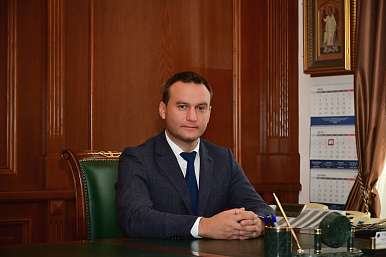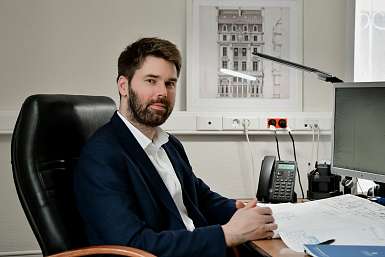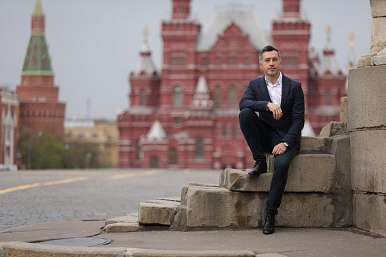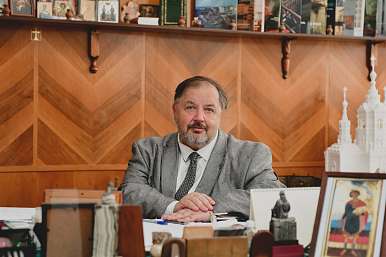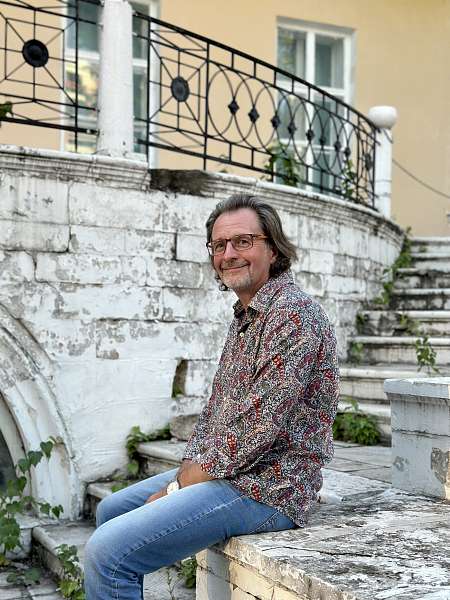
You can spend your whole life studying Moscow. Digging into the material through the prism of people’s lives or historical facts, using technology or music and poetry associations, or treating the city as if it were a person known for a long time, but arousing the best feelings. It is important to find unique sites and new stories every time, which only improve cognitive interest.
Mikhail Zhebrak, host of the TV show “On Foot” on the Russia-K channel, spoke about how to turn a hobby into a career, about the role of history and cultural heritage among young people, as well as about the role of state-of-the-art technologies in getting to know history.
– Mikhail Yurievich, you are known for your passionate love for Moscow! You have created three Moscow guides and host a TV show on the Russia-K channel, which has been on the air for 12 years. How did your get interested in walking around the city?
– I can no longer remember when and how this interest was born. I just wanted to know more about my hometown, so I studied Moscow from my youth, passionately writing down interesting facts from newspapers and books in my notebook. I think for such a restless person like me, grinding away at studies was and still is taming. To turn quantity into quality, I gave myself the task of visiting all memorial museum-apartments, joining all libraries, visiting all Moscow parks. I am exaggerating, of course – I have only joined nine out of a hundred Moscow libraries, and last time I visited the park with my film crew.
Local history has always attracted me: I wrote a local history column in the Moskovsky Komsomolets newspaper and wrote materials for the Culture column. Then there were other newspapers and radio.
– I guess you have been doing what you love all your life.
– Well, yes, my hobby became my profession over time.
– How can you describe your attitude towards Moscow?
– Now I treat our city like a relative, which, however, you get tired of. But after separation you enjoy the happiness of meeting.
– How does work on books and podcasts begin? Do you feel like you already know almost everything, or do you manage to discover something new in the process?
– Of course, there is the feeling that everything has already been said. It is like visiting the Red Square for the tenth time and exclaiming: “Oh, this is something new!” Viewers and listeners can no longer be surprised by stories, for example, about Leningradsky Railway Station – all the interesting historical facts and curiosities have long been known. Even an interesting thought is difficult to repeat; it will only work if it is voiced at the moment.
However, information is an inexhaustible resource, which can be accessed through different prisms: people or facts, technologies or associations.
Some people write, some take photographs of Moscow, but for me, urban sites are associated with poetry – in my TV shows I use great works that, in my opinion, correspond to this or that object in Moscow.
– Please, tell us about the most amazing building or place you were lucky enough to visit.
– I always notice something curious! For example, the institute where Pyotr Kapitsa worked. The site is semi-abandoned, there are some completely abandoned rooms – it is incredibly interesting. At the same time, it is not such a “derry,” as young people would say, scientists still work there, and the house of P. Kapitsa has also been preserved. An indescribable feeling!
Zinaida Morozova mansion (Reception House of the Russian Foreign Ministry, 17 Spiridonovka Street) remains in my memory. I was lucky enough to shoot for three times there, including a separate TV show about this building. The texture: both the historical context and the interiors of the building helped us create an interesting TV show. Working in the mansion built by Fyodor Schechtel and Mikhail Vrubel, telling the mystical story of Savva Morozov, his murder or suicide in Nice, is a great professional success. By the way, we found an approach for such a story. We filmed using chroma key compositing, and I was both the host and the ghost.
But it depends not only on the architecture. I have always admired the sculptures of Stepan Erzya, but this love was distant. The fact is that there are few of them in Moscow – 4 of his works are exhibited in the Tretyakov Gallery, and other 30 are kept in the storerooms of the Russian Museum. Although I understood that falling in love with a sculpture from pictures was the worst thing that could happen, the images left no doubt: the works of a genius were in front of me.
Luckily, the Republic of Mordovia invited us to Saransk to make a film about Erzya, where there is a museum entirely dedicated to his work, with a collection of 200 works on display. Such projects inspire us and inevitably offer new discoveries. Just imagine: looking at Erzya’s work, my cameraman, a person who perceives art with his soul, and not through the prism of cold facts and technology, exclaims: “It is very similar to Sergey Konenkov, but this work is stronger!” After that we discuss not the filming process: tricks and plans, but the era, the friendship of Erzya and Konenkov, the features of their creative methods...
– Your projects are popular among young people. Do you think that history and cultural heritage are popular again? Or did this trend never stop?
– Young people are always eager to be integrated into life and strive to discover the places in which they live. Today, it is easier than ever to satisfy these desires, as history has become available.
For example, travel has already outgrown pilgrimage or kayaking, and is becoming applied local history. There is more than enough information – there are bloggers and relevant literature. Moreover, people often get to know places through everyday things: delicious coffee, old bakeries, and so on. There is nothing wrong with that! We once learned to love Moscow reading Gilyarovsky’s works.
Moreover, tours with its surges have been popular for 15 years: there were geosearch quests for young people, the Running City project, scooters and traditional tours. Young people can select tour formats, they often like interactive programs.
– I would like to discuss Morozova mansion. Recently, GlavUpDK under the MFA of Russia has introduced a mobile app with the immersive performance “Inside the Mansion,” allowing visitors to take a “walk” through this building. What is the role of state-of-the-art technologies in getting to know history? Is this form capable of attracting the attention of young Russians to the history of their Fatherland?
– Recently, in one of my TV shows, I have compared the Tretyakov Gallery with the Glazunov Gallery. The first one thinks: “Let us start from the beginning: from the 18th century, Classicism – Romanticism – the Wanderers.” Pavel Tretyakov said: “I have a collection, do not increase it any more, I have already bought all the best. Leave it the way I hang it,” – collectors should be like that. They really bring it to closure, they stop time.
At the same time, the Tretyakov Gallery opened the Tretyakov Brothers Museum on the site of the burnt house in which the brothers were born. They built everything anew, created an ultra-modern exhibition with stands that you can touch with your hands and “talking” heads. The first floor is multimedia, the second floor contains original objects integrated into the restored interior. Visiting the museum becomes an amazing game: guests guess what is real and what is added. This approach is 100% effective.
Another example is the Glazunov Gallery with an admirable collection to study history from the originals. The famous artist was a very wealthy man. Madly in love with collecting, he had an extensive collection. The gallery has three floors dedicated to the artist’s collection: a round hall – a rotunda – with life-size portraits of our sovereigns, as they were supposed to be painted in the 18th-19th centuries. Ilya Glazunov is our contemporary, but the museum seems to be from the 19th century with the old approaches, using the right German technologies: stands, stained glass windows, fences so that no one gets through anywhere...
In my opinion, the future is the symbiosis of the authentic and the new. The key is to strike a careful balance and not to lose authenticity while trying to attract an audience.
I have experience collaborating as a consultant, a Moscow specialist, with teams who then processed the material using modern means of presenting information. Young people love it, and it is great, but I am of a different age, and I am not very comfortable with these formats.
– Let your imagination run wild. Which sites need state-of-the-art technologies?
– Imagine that you come to the St. Clement’s Church in Zamoskvorechye District, and the three-dimensional abbot says to you: “Everything I have is original, the iconostasis dates from 1772...”, and he tells you the history of the place and the shrines. All this is beautifully “packed” with stories. Such projects are certainly the future.
There are many such ideas. For example, I have recently met so-called Manilovs, who dreamed of placing binoculars at the Resurrection Gate, where you could see pictures made 200–300 years ago.
Indeed, it would be interesting to see the early 20th century city. For example, a cartoon featuring the central squares of Moscow: Gilyarovsky travels in a cab past half-drunk Savrasov, drunken artist; the policeman immediately salutes you when he sees that you look at him. Technologies allow specialists to recreate these stories. If you turn the wheel of your binoculars, historical eras change: from modern times through Stalin’s high-rise buildings to pre-revolutionary buildings.
– What is your favorite architectural style?
– Like all Muscovites, I love classical architecture and believe that Russia is the birthplace of this style. But the Classicism Moscow burned down in 1812, and the Empire style appeared – what we now see in the city. Constructivism also touches me. The honesty of the late 20s and early 30s is also curious. I will also highlight the revival of Neoclassicism, the Russian style dating from the late 19th century.
I am interested in studying the history of architecture. I am curious about the connections. I am not negative about any style, even modern architecture does not irritate me – it is clear that people put much effort in it.
Modern bloggers have come up with a new term – Caprom – capitalist romanticism: a lot of glass, columns, lush and rich, with modernity attempts. But it is not modern architecture, but a little bad taste.
Sometimes I see small towns being transformed, and people say: “Bad taste!” But what is the criterion?! 18th century? Paris? Saint Petersburg? Remember, Moscow was once considered a provincial city, with the architecture that caused laughter.
– What is your assessment of the preservation of the capital’s historical sites?
– Unfortunately, we do not have the idea and goal of preserving in the genes. This was the case in the 18th century – Catherine the Great demolished the Kremlin and was going to build a palace in its place, renovations also took place in the 19th century; on the top of that, the Soviet times. This is our peculiarity, our mentality: we do not know how to live in the old, we do not know how to enjoy it and appreciate the past.
At the same time, the city cannot help developing, no matter how much they want to preserve old Moscow, this is impossible. What moment is to be preserved? 1610? 1832? That is why they come up with all sorts of lists: this building is unique, there are so-and-so many of them, and this one is a little less unique, but they should also be preserved, there are so-and-so many of them. Let there be lists! Until we learn to appreciate, we will still rebuild Moscow.
Of course, historical buildings are gradually disappearing. Some iconic mansion will never be demolished, I believe. But do we need to preserve this three-story old house standing behind this mansion? Yes and no. It all comes down to money in the end.
Let us take fortifications – the walls are preserved not because of the historical heritage, but as dismantling is expensive, which is why they have been preserved in many Italian towns. Where there is money, there are no walls.
Living in an old house means being prepared to maintain it, assuming the following modality: “I will restore it with my own money. At least, I will install an air conditioner in the refrigerator, just so that it does not stick out on the façade.”
– More and more historical buildings are being adapted for modern use, combining historical context with functionality. What is your attitude towards this activity? Which modern practices do you consider the most successful?
– I am extremely positive! The clearest example of this is the Helikon-Opera Theater. The owner of the house on 19 Bolshaya Nikitskaya Street was a capricious woman: the façade was in one style, the courtyard was in another, the interiors were completely different. The courtyard with the sowbelly porch is in the Russian style. Today, a huge pit was dug on this site and the auditorium was lowered into it, so that the former porch became the royal box. The stage is now where the coach house used to be, just lower down, and the top decoration of the barn has become the decoration above the arc of the stage. The building has preserved its history and continued life.
I like rational use, when the protected old things start new life and acquire new functions.
– What do you think Moscow will be like in 20–40–60 years? Will it be able to come to the future, preserving the memory of past eras?
– Not the last writer, the smartest Herbert Wells at the end of the 19th century said: “London will be filled with horse manure up to the second floor of houses. The population is growing – so many horses will be there.” He was wrong! But even now nothing has changed, it is difficult to imagine what our future will be like, technology is changing the world so much.
It seems to me that the trend is towards preserving façade rows or only façades of buildings dating from the 18th and 20th centuries as the first line with modernity in depths. Moscow City and the infill development of the past in front of it seem to be our movement vector. Again, I do not think I have guessed it right... (note: he smiles)
– How can a person without specialized education learn to understand architecture?
– It is not difficult: books and the Internet can help. It is important not only to study materials, but also to find a guide to the world of new information: a professor, a journalist, a blogger, a critic.
Grigory Revzin, one of the best architectural critics of our time, became such a guide for me. He is a professor who has been arousing my educational interest for many years.
– What is your favorite area or building in Moscow?
– Once again, Moscow and its areas are like a big family for me – there are no favorites, but everything is interesting. I like the areas where I live: Tekstilshchiki, Novogireevo – whatever, Pushkin Square, where I studied... But again, this love is similar to the one you feel for a relative whom you have known for a long time.
There are sites that refresh my memory from childhood and youth – moments when everything was for the first time – brighter, sharper, more curious. They are touching and warm.
– If you could travel back in time, what era would you choose? Which one is of most interest?
– Of course, I do not want to travel back to those days when Peter the Great cut off heads. It sounds exciting, but only while reading novels. I would like to be in the late 19th century, when Moscow was diverse, used horse-drawn vehicles and no sewerage. A tramp, a lady wrapped in 3-4 layers of fabric even in summer and a man in a three-piece suit and patent leather gloves used to walk along the same sidewalk. It would be interesting to see and feel this city.
The smells and sounds offer a completely different experience. There are places on Earth where such picture is still alive. For example, Cairo has almost no cars in some areas, people move around using donkeys, strollers and bicycles. This looks exotic, even frightening, but this is what life was like in Moscow a little less than two centuries ago. “Oh, but this is the East!” – No, this is not the East, this is Moscow: Kitay-Gorod, center, 19th century.
